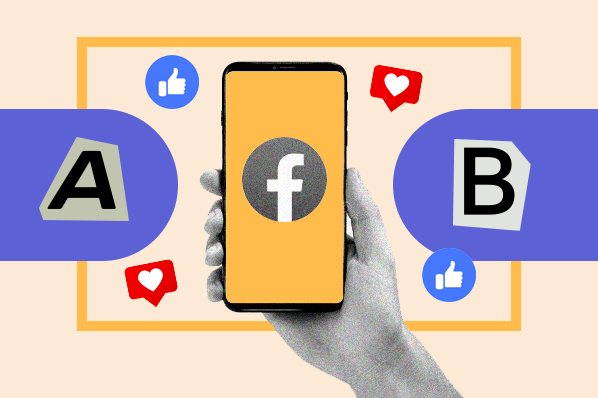I’m usually pretty irritated when I’m watching something and a pop-up blocks my view. I try to hit that x like I’m playing whack-a-mole. But when I’m scrolling through social media and see something that tells a story or makes me laugh, I’ll stop and watch no matter who posted the content — a person or a brand.

That second kind of advertising is called native advertising. There’s usually a small label telling me if a post is sponsored content, but that’s less important to me than the quality of the content. Brands who master native advertising strategy create relatable content, show engaging visuals, and make their customer the hero.
Follow along to find native advertising best practices and how to launch your first campaign.
Table of Contents
- How Native Advertising Works
- When to Use Native Advertising
- How to Run a Native Ad Campaign
- Run Your Native Campaign Like a Pro
How Native Advertising Works
Native advertising is a type of digital advertising where the format mimics organic content on the platform. Here are a few examples you’ve probably encountered:
- A sponsored TikTok video that appears in the feed alongside other user videos.
- A boosted influencer video or post on Instagram.
- Recommended content at the end of an article.
- A sponsored Google result that appears above organic search results.
There are a few reasons native ads perform well. First, the ad blends in seamlessly with the content instead of “interruptive” placements like pop-ups. (There’s usually a small disclaimer or label showing the content as paid advertising.)
Second, the best native ads offer value-based content designed to be entertaining or informative for the user, rather than pushing a product. This naturally makes native advertising more engaging.
When to Use Native Advertising
There are several situations where you should consider making native ads part of your marketing mix.
1. Display advertising isn’t producing the results you want.
Display advertising is the traditional method of digital marketing where ads display on a sidebar, banner, or pop-up of a website or platform. While these can be effective, click-through rates (CTR) are abysmally low. As internet users, we’ve trained ourselves to largely ignore these ads in a phenomenon known as ad blindness.
The Channel Report found that standard ad formats average a CTR of 0.12%, while native ads average 0.3%. Native ads also receive 53% more views than traditional ads and experience 530% higher video engagement.
2. You want higher engagement.
Native ads are good at engaging the viewer. When done well, native ads are very good at drawing and keeping a person’s attention. Outbrain reports that native ad campaigns benefit from 28% higher time spent and 180% higher leads.
In our State of Inbound Marketing Trends, B2C brands reported that native advertising drove one of the best ROIs.
3. You want to build brand awareness.
Another area where native advertising shines is in building brand awareness. A study by Tabooka and Kantar found that native advertising resulted in a brand favorability lift of 15% over traditional ads, a brand awareness lift of 10%, and a message association lift of 87% — eight times the industry average.
Our State of Inbound Marketing Trends found that B2C brands in particular experience high ROI from native advertising.
4. You have a young target audience.
Here’s a harsh truth: Gen Z doesn’t want to see your banner ad. Research from Bulbshare found that 75% of Gen Z (born between 1997–2012) will avoid ads at all costs. That means skipping ads (99%), installing an ad blocker (63%), or physically leaving the room while an ad plays. The worst offender is pop-up ads, followed by social media ads.
That doesn’t mean that younger audiences aren’t open to branded content, though.
36% of Gen Z turns to social media over search engines to search for brands, and 39% say that social media has influenced them to buy something. They simply want a different format than we’ve used to reach audiences in the past.
.png)
Free Advertising Planning Kit
Plan and launch an effective and profitable advertising campaign with this guide and set of templates.
-
An Overview of Popular Advertising Methods
-
The Pros, Cons, and Costs of Advertising Types
-
A Planning Template to Outline Timeline, Budget, and Goals
-
A Project Pitch Presentation Deck to Share With Stakeholders
How to Run a Native Ad Campaign
Now, we come to the heart of it: How do you create a native ad strategy and launch your first campaign?
1. Define campaign goals.
Before you start on any creative, decide the goals of your native ad campaign. This will help you decide on your ad platform and help you measure its effectiveness.
Visibility and Brand Awareness
How many people will see your content, and will they recall your brand or messaging afterward? Brand awareness may not lead to immediate sales but builds visibility and consumer trust over time.
Measured by: Impressions, pageviews, and message or brand recall.
Engagement
To what extent will viewers interact with your content? Engagement builds connections with viewers and can also help you build an audience on that platform.
Measured by: Time spent, click-through rate, engagement rate, referrals, and new follower rate.
Lead Generation or Sales
Will the campaign lead to conversions, including signups, new leads, and sales?
Measured by: Leads, downloads, in-app purchases, and conversions.
2. Choose a target audience.
Next, research your audience to determine factors like target age, gender, and other demographics. Then, go beyond demographics to ask what their motivations are, what challenges you’re trying to solve for them, and what type of content they want (or don’t want) to see.
Gathering this data will help you choose the best platform and create content your audience won’t skip or block.
3. Select your publishing platform.
There are many publishing platforms for your content — so where do you start? First, I’d advise starting where you already have a presence. If you’re already active on social media, start with those platforms you have a presence on. If you’re already creating great blog and website content, promote your content through search or programmatic advertising.
Next, go back to your target audience data and choose platforms where your audience spends the most time.
Search Ads
One common form of native advertising is search ads. Google’s native ads populate above top search results for relevant queries, like the search below for “tutoring service.” Search ads integrate seamlessly into the search experience, have high visibility, and use flexible components, so Google Ads will reformat it for you.
Google is a great platform for reach since it accesses 80% of global internet users, but it can become expensive depending on the niche.

Download link: https://offers.hubspot.com/google-ads-ppc-kit
YouTube Video Ads
Since Google owns YouTube, you can run video campaigns on both platforms at once. Another popular type of native ads is discovery ads, which populate on the YouTube homepage and Watch Next page ads.
Programmatic Advertising
Another form of native ads is recommended content that is published across multiple media sites, called programmatic advertising. In the U.S., 90% of digital ads are purchased this way. Recommended content typically appears below an article or other content, like the CNN example below.

Rather than the old media buying method where brands contact media sites individually to book ad space, brands can use a native ad network to place native programmatic ads across many platforms. These networks, like Outbrain, Taboola, and Nativo, use a sophisticated bidding and targeting system for placement.
Programmatic ads can run on contextual targeting, based on similarity to the content on the page, or behavioral targeting, based on the person’s actions. For example, retargeting ads use behavioral targeting to serve relevant content to internet users who have shown interest in a type of product or brand.
Social Media
Lastly, publishing native ads on social media is a great way to add your voice to the conversation. Start with the platforms you’re already active on and consider which platforms your audience frequents the most, like LinkedIn for B2B companies. If you have a type of content in mind, start with platforms best suited to that content type. Native video ads are best for TikTok and YouTube, while image posts are best for Instagram and Pinterest.
Top Social Media Platforms for Native Ads
|
Native Ad Platform |
Native Ad Formats |
Monthly Active Users (MAU)* |
Largest Age Demographic* |
|
Sponsored posts (text, photo, or video), Facebook ads, influencer marketing posts |
3.03 billion |
25-34 |
|
|
Sponsored posts (stories, reels, photos, video, or feed video), influencer marketing posts |
2.4 billion |
25-34 |
|
|
TopViews, brand takeovers, hashtag challenges, branded effects, in-feed ads, spark ads |
1.56 billion |
18-24 |
|
|
Sponsored content, message ads, dynamic ads |
1 billion |
25-34 |
|
|
Standard pin, video, idea, carousel, collections, shopping, showcase, quiz |
482 million |
25-34 |
|
|
In-feed, skippable in-stream, outstream |
2.7 billion |
25-34 |
*Source: Demandsage
4. Establish your campaign budget.
The first step in setting your campaign budget is to pick a pricing model. Most native ads use a bidding structure to determine ad pricing, so the cost of an ad will depend on the competitiveness of the audience and keywords you’re targeting. Pricing also varies by ad placement, geographic location, and format. There are two primary bidding models: cost-per-click (CPC) and cost-per-mille (CPM).
Cost-Per-Click (CPC)
CPC is a model where you only pay when a user clicks on your ad or links through to your website. This pricing approach is best for brands trying to drive website traffic and leads, since they will only pay for the result they want.
Cost-Per-Mille (CPM)
The CPM model charges you for every thousand impressions your native ad receives. Choose this model if you’re prioritizing visibility and brand awareness. CPM is often more cost effective, but you may be paying for a campaign with few results.
Average Costs for Native Ads
It’s difficult to estimate costs for a campaign because of all the factors listed above. You’ll need to do some research or create a draft campaign to see specific bid estimates, but here are some general cost estimates compiled by the Native Advertising Institute.
|
Native Ad Platform |
Average CPC Cost |
Average CPM Cost |
|
Facebook & Instagram |
$0.20-$2 for Instagram; $0.20-$1 for Facebook |
$5-$20 |
|
TikTok |
N/A |
$10 (required $50 daily budget) |
|
|
$3-$9 |
$6-$9 |
|
Content discovery networks (Taboula, Outbrain, etc.) |
$0.10-$0.50 |
$3-$7 |
|
Google Ads* |
$2.69 (recommended $10-$50 daily budget) |
N/A |
*Source: Wordstream
When starting out, give yourself a minimum dollar amount, like $500, so you have enough budget to test your campaign and build momentum.
While each platform is different, most let you set a daily spending limit, a monthly spending limit, and a total campaign limit. This lets you run a campaign without worrying about going over budget!
.png)
Free Advertising Planning Kit
Plan and launch an effective and profitable advertising campaign with this guide and set of templates.
-
An Overview of Popular Advertising Methods
-
The Pros, Cons, and Costs of Advertising Types
-
A Planning Template to Outline Timeline, Budget, and Goals
-
A Project Pitch Presentation Deck to Share With Stakeholders
5. Create Appealing Content
Finally, it’s time to create great content. Remember that native ads should feel natural and unobtrusive. To accomplish this, mimic the style of successful content in your niche. Use authentic storytelling and a voice and tone that matches your customers. Or better yet, the actual voice of your customers.
In our annual social media survey, we asked social media marketers which types of content drove the best ROI. Here’s what they shared.

Download CTA: https://offers.hubspot.com/social-media-trends-report
The content that performs the best for brands is relatable, informational, interactive, and joins in with cultural moments. To do this, follow the tips below.
1. Use the customer’s voice.
While you should mention your brand name in native ads, don’t make it the focus. Make the customer the hero instead. You can do this in one of two ways. First, encourage user-generated content (UGC). Share and promote content your customers have made about your product or service.
Second, you can partner with creators for an influencer marketing collaboration. Our research found that influencer marketing is growing fast, with 50% of brands planning to increase their investment in 2024. Simply put, customers are much more likely to listen when an influencer they like is talking about your brand instead of you.
Take the example below, where The Farmer’s Dog food brand partnered with Brodie the Goldendoodle (and his owner) on TikTok.
The resulting TikTok Spard Ad is short, conversational, and in a Q&A format, which is true to the creator’s voice. Plus, an adorable dog doesn’t hurt. This campaign racked up 33 million views for The Farmer’s Dog and a 31% click-through rate.

2. Keep it short.
To stop the scroll, make your ad engaging from the very first second. For example, TikTok recommends keeping a video between 21 and 34 seconds and mentioning the brand name in the first three seconds. Pinterest’s recommendation is even shorter: 6 to 15 seconds for optimal engagement.
While there are some exceptions to this (like Salesforce’s award-winning Ecopreneur docuseries), most of the time, briefer is better.
3. Maximize multimedia.
For the best chance of holding your audience’s attention, use every sensory tool available to you.
Native ads with images and videos perform particularly well. Google recommends you include at least four unique image assets with each ad. Carousels on platforms like Pinterest can draw someone in to look and engage.
Text on an image or video also helps connect you to people who may be watching on mute. You can leverage trending audio on TikTok for even more engagement. Of TikTok users, 68% say they remember a brand better when it features a song that they like in the content.
4. Use compelling copy.
The best native ads use succinct, actionable copy to get their message across. You need a headline that will connect and body copy that will drive users to action.
Take this native Pinterest ad from baggage brand Foldie. It’s designed in the style of a travel video showcasing the bag in use in different scenarios. The text highlights key benefits, including “Need more space? The Foldie expands!” and “Move swiftly through the airport!”
At the end, there’s a clear “Shop Now” CTA. The ad stands out against other native ads on the page that simply show a photo of the luggage item.

For more inspiration, visit our roundup of the top native ad examples.
6. A/B test your content.
Most platforms have a way for you to A/B test your ads. By comparing different versions of ads and analyzing performance metrics, you gain insights into what will resonate with your audience.
You can also use AI-powered tools like Google’s Ad Strength rater to predict how an ad will perform. Testing lets you optimize your campaigns before you invest a large budget into an ad campaign that misses the mark, giving you a chance to recalibrate.
7. Launch your campaign.
Once you’ve created and A/B tested your content, it’s time to go live. Before you do, ensure your landing pages and commerce funnels are ready to receive traffic. LinkedIn reports that 80% of its sponsored content engagement comes from mobile devices, so make sure your website or landing page is responsive.
8. Track metrics.
Go back to your campaign goals from the very start of the campaign. Monitor the KPIs that indicate whether you’re moving toward your goals, such as impressions, CTR, or leads.
Continue a cycle of monitoring and adjusting your campaign based on what’s working or what’s not. By this method, you can continually improve and optimize it for the best performance.
Monitor metrics like CPC and CPM to ensure that your ad is as cost-effective as possible. Last, follow conversion metrics so you can calculate the ROI of your ad campaigns.
Run Your Native Campaign Like a Pro
Native ads are a flexible ad category with endless possibilities: video, text, images, and even interactive content. Your audience is looking for creative content, so don’t limit yourself. Think like a creator and invite the voice of the customer into your content for the very best native ads.
Editor's note: This post was originally published in June 2014 and has been updated for comprehensiveness.





![How to Boost a Post on Social Media [Instagram, Facebook, and Twitter]](https://blog.hubspot.com/hubfs/marketers%20about%20to%20boost%20social%20media%20posts%20on%20platforms%20like%20instagram%20facebook%20and%20twitter.jpg)




